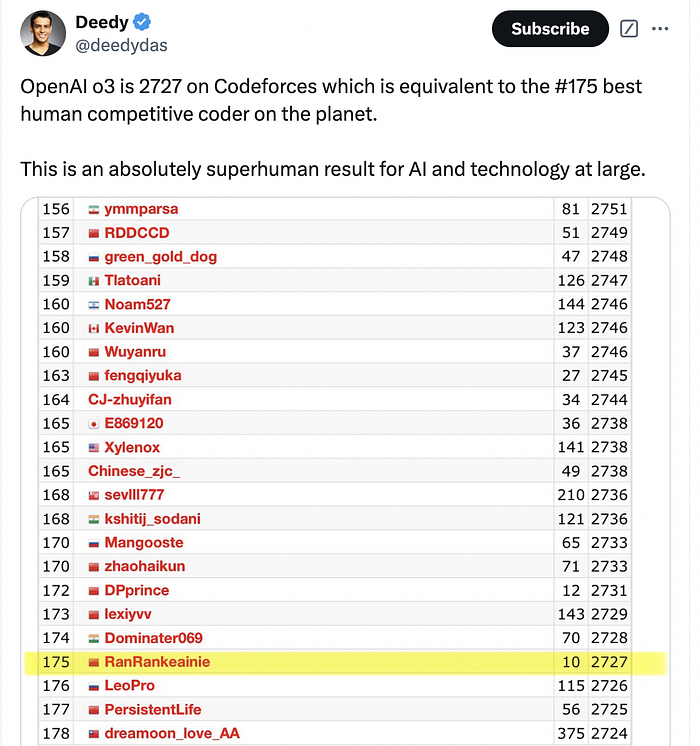Artificial intelligence (AI) continues to revolutionize industries, and software development is no exception. OpenAI’s latest AI model, o3, has garnered significant attention for its impressive coding capabilities, ranking as the 175th best competitive coder globally. This milestone has ignited conversations about AI’s potential to transform the software engineering job market.
In this article, we will explore OpenAI o3’s achievements, its practical applications, the concerns it raises, and its implications for the future of software development.
OpenAI o3’s Competitive Coding Prowess
The ranking of OpenAI’s o3 model among the top competitive coders is no small feat. Competitive coding requires solving complex algorithmic problems under tight constraints — a domain traditionally dominated by highly skilled human coders.
Implications of o3’s Achievement
- Demonstrating AI’s problem-solving capabilities: o3’s rank highlights the rapid advancement of AI in tackling logical and algorithmic challenges.
- Benchmarking AI’s progress: Its placement provides a quantitative measure of how close AI is to replicating human-like coding expertise.
- Raising the bar for AI models: This achievement sets a precedent for what future AI systems may achieve in technical domains.
Practical Application Concerns
Despite its success, applying o3’s capabilities to real-world software development poses challenges.
High Computational Costs
Running advanced AI models like o3 requires immense computational resources, making it prohibitively expensive for many businesses.
- Cost comparison:
- Hiring a mid-level software developer: ~$100,000 annually.
- Operating o3 for the same duration: Significantly higher due to energy and hardware costs.
This raises questions about the economic feasibility of deploying AI at scale in everyday software projects.
Comparison with OpenAI o1
OpenAI o3 builds on the foundation of its predecessor, o1, but with notable advancements.
Improvements in o3
- Better problem-solving capabilities: o3 handles more complex tasks than o1, achieving higher rankings in competitive coding.
- Enhanced precision: It generates cleaner, more optimized code.
Remaining Limitations
- Contextual understanding: While improved, o3 still struggles with ambiguous or poorly defined requirements.
- Generalization: It excels in competitive coding but faces challenges in translating these skills to the messy, collaborative nature of real-world software development.
Sentiments Among Software Developers
The rise of AI in coding has sparked mixed reactions among software engineers.
Positive Perspectives
- Time-saving potential: Developers see AI as a tool to handle repetitive tasks, freeing them to focus on creative problem-solving.
- Improved productivity: Many believe AI can accelerate development timelines and enhance code quality.
Concerns and Skepticism
- Job displacement fears: Some worry that AI could replace human coders, especially for entry-level roles.
- Trust issues: Developers are cautious about relying on AI for mission-critical applications due to potential errors.
Quote from a developer: “AI like o3 is amazing, but it’s not ready to replace engineers. It’s a tool, not a substitute.”
AI Augmenting vs. Replacing Engineers
Rather than replacing engineers, AI is likely to augment their roles.
How AI Augments Software Engineering
- Automating repetitive tasks: Writing boilerplate code, generating test cases, and refactoring code are areas where AI shines.
- Improving focus on higher-level tasks: By offloading mundane work, developers can concentrate on architecture, design, and innovation.
Changing Nature of Work
AI is expected to shift the focus of software engineering from manual coding to higher-level problem-solving and system design.
Limitations of Competitive Coding as a Metric
While competitive coding is an impressive benchmark, it doesn’t fully reflect the demands of real-world software development.
Key Differences
- Collaborative nature: Real-world projects often involve teamwork, communication, and iterative development — areas where AI still lags.
- Domain knowledge: Understanding the nuances of specific industries and integrating that knowledge into software is something humans excel at.
Real-World Complexities
AI models like o3 can solve pre-defined problems but struggle with ambiguous requirements or dynamically changing project scopes.
Cost and Economic Sustainability
The high computational cost of running AI models like o3 is a significant barrier to widespread adoption.
Current Costs
Operating a model like o3 is energy-intensive, requiring specialized hardware and constant maintenance.
Potential Solutions
- Advancements in hardware: Developing more energy-efficient chips could lower costs.
- Optimized AI models: Future iterations of AI may become leaner, requiring less computational power.
Future Trajectory of AI in Coding
The road ahead for AI in software engineering is filled with both promise and challenges.
Potential Breakthroughs
- Natural language coding: AI generating complex code from plain-English descriptions.
- Real-world project management: Integrating AI into the end-to-end software development lifecycle.
Challenges to Overcome
- Reducing costs and improving efficiency.
- Addressing limitations in contextual understanding and adaptability.
Ethical Considerations
As AI becomes more prominent in coding, ethical questions must be addressed.
Key Issues
- Bias in training data: AI models may inadvertently reflect biases present in the datasets they’re trained on.
- Accountability: Determining responsibility for errors in AI-generated code is a complex challenge.
- Potential misuse: Malicious actors could exploit AI-generated code for harmful purposes.
Conclusion
OpenAI’s o3 represents a significant leap in AI’s capabilities, showcasing its potential to transform software development. While it excels in competitive coding, real-world applications still present challenges such as cost, contextual limitations, and ethical concerns.
AI is not poised to replace software engineers but to augment their roles, automating routine tasks and enabling them to focus on innovation. The future of AI in coding is bright, but navigating its complexities will require collaboration between technologists, ethicists, and policymakers.
The question is not whether AI will shape the future of coding — it’s how we will adapt to harness its full potential.

